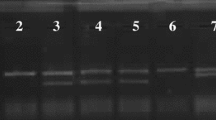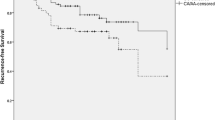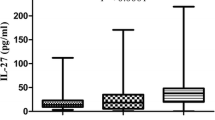Abstract
To assess whether polymorphisms of the interleukin-23 receptor (IL23R) gene are associated with bladder transitional cell carcinoma because chronic inflammation contributes to bladder cancer and the IL23R is known to be critically involved in the carcinogenesis of various malignant tumors. 226 patients with bladder cancer and 270 age-matched controls were involved in the study. Polymerase chain reaction–restriction fragment length polymorphism was used for genotyping. Genotype distribution and allelic frequencies between patients and controls were compared. In all three single nucleotide polymorphisms of IL23R studied, the distribution of genotype and allele frequencies of rs10889677 differed significantly between patients and controls. The frequency of allele C of rs10889677 was significantly increased in cases compared with controls (0.2898 vs. 0.1833, odds ratio 1.818, 95 % confidence interval 1.349–2.449). The result indicates that IL23R may play an important role in the susceptibility of bladder cancer in Chinese population.
Similar content being viewed by others
References
Siegel R, Naishadham D, Jemal A (2013) Cancer statistics, 2013. CA Cancer J Clin 63(1):11–30. doi:10.3322/caac.21166
Cresswell J, Robertson H, Neal DE, Griffiths TR, Kirby JA (2001) Distribution of lymphocytes of the alpha(E)beta(7) phenotype and E-cadherin in normal human urothelium and bladder carcinomas. Clin Exp Immunol 126(3):397–402
Leibovici D, Grossman HB, Dinney CP et al (2005) Polymorphisms in inflammation genes and bladder cancer: from initiation to recurrence, progression, and survival. J Clin Oncol 23(24):5746–5756. doi:10.1200/JCO.2005.01.598
Parham C, Chirica M, Timans J et al (2002) A receptor for the heterodimeric cytokine IL-23 is composed of IL-12Rbeta1 and a novel cytokine receptor subunit, IL-23R. J Immunol 168(11):5699–5708
Kim TH, Hong JM, Oh B et al (2008) Association of polymorphisms in the Interleukin 23 receptor gene with osteonecrosis of femoral head in Korean population. Exp Mol Med 40(4):418–426
Huber AK, Jacobson EM, Jazdzewski K, Concepcion ES, Tomer Y (2008) Interleukin (IL)-23 receptor is a major susceptibility gene for Graves’ ophthalmopathy: the IL-23/T-helper 17 axis extends to thyroid autoimmunity. J Clin Endocrinol Metab 93(3):1077–1081. doi:10.1210/jc.2007-2190
Sung IH, Kim TH, Bang SY et al (2009) IL-23R polymorphisms in patients with ankylosing spondylitis in Korea. J Rheumatol 36(5):1003–1005. doi:10.3899/jrheum.081121
Langowski JL, Zhang X, Wu L et al (2006) IL-23 promotes tumour incidence and growth. Nature 442(7101):461–465. doi:10.1038/nature04808
Chen J, Lu Y, Zhang H et al (2010) A nonsynonymous polymorphism in IL23R gene is associated with risk of gastric cancer in a Chinese population. Mol Carcinog 49(10):862–868. doi:10.1002/mc.20661
Chien MH, Hsin CH, Chou LS et al (2012) Interleukin-23 receptor polymorphism as a risk factor for oral cancer susceptibility. Head Neck 34(4):551–556. doi:10.1002/hed.21779
Wang L, Liu W, Jiang W et al (2012) A miRNA binding site single-nucleotide polymorphism in the 3′-UTR region of the IL23R gene is associated with breast cancer. PLoS ONE 7(12):e49823. doi:10.1371/journal.pone.0049823
Zhang Z, Zhou B, Zhang J et al (2010) Association of interleukin-23 receptor gene polymorphisms with risk of ovarian cancer. Cancer Genet Cytogenet 196(2):146–152. doi:10.1016/j.cancergencyto.2009.09.006
Duerr RH, Taylor KD, Brant SR et al (2006) A genome-wide association study identifies IL23R as an inflammatory bowel disease gene. Science 314(5804):1461–1463. doi:10.1126/science.1135245
Newton RC, Beral V, Weiss R, Imperial Cancer Research Fund (Great Britain) (1999) Infections and human cancer. Cold Spring Harbor Laboratory Press, Plainview
Balkwill F, Mantovani A (2001) Inflammation and cancer: back to Virchow? Lancet 357(9255):539–545. doi:10.1016/S0140-6736(00)04046-0
Macarthur M, Hold GL, El-Omar EM (2004) Inflammation and cancer II. Role of chronic inflammation and cytokine gene polymorphisms in the pathogenesis of gastrointestinal malignancy. Am J Physiol Gastrointest Liver Physiol 286(4):G515–G520. doi:10.1152/ajpgi.00475.2003
Tsai FJ, Chang CH, Chen CC, Hsia TC, Chen HY, Chen WC (2005) Interleukin-4 gene intron-3 polymorphism is associated with transitional cell carcinoma of the urinary bladder. BJU Int 95(3):432–435. doi:10.1111/j.1464-410X.2005.05315.x
Marsh HP, Haldar NA, Bunce M et al (2003) Polymorphisms in tumour necrosis factor (TNF) are associated with risk of bladder cancer and grade of tumour at presentation. Br J Cancer 89(6):1096–1101. doi:10.1038/sj.bjc.6601165
Chen T, Jackson C, Costello B et al (2004) An intronic variant of the TGFBR1 gene is associated with carcinomas of the kidney and bladder. Int J Cancer 112(3):420–425. doi:10.1002/ijc.20419
Kang S, Kim YB, Kim MH et al (2005) Polymorphism in the nuclear factor kappa-B binding promoter region of cyclooxygenase-2 is associated with an increased risk of bladder cancer. Cancer Lett 217(1):11–16. doi:10.1016/j.canlet.2004.06.053
Pirhonen J, Matikainen S, Julkunen I (2002) Regulation of virus-induced IL-12 and IL-23 expression in human macrophages. J Immunol 169(10):5673–5678
Dunn GP, Bruce AT, Ikeda H, Old LJ, Schreiber RD (2002) Cancer immunoediting: from immunosurveillance to tumor escape. Nat Immunol 3(11):991–998. doi:10.1038/ni1102-991
Dunn GP, Old LJ, Schreiber RD (2004) The three Es of cancer immunoediting. Annu Rev Immunol 22:329–360. doi:10.1146/annurev.immunol.22.012703.104803
Dunn GP, Old LJ, Schreiber RD (2004) The immunobiology of cancer immunosurveillance and immunoediting. Immunity 21(2):137–148. doi:10.1016/j.immuni.2004.07.017
Langowski JL, Kastelein RA, Oft M (2007) Swords into plowshares: IL-23 repurposes tumor immune surveillance. Trends Immunol 28(5):207–212. doi:10.1016/j.it.2007.03.006
Numasaki M, Fukushi J, Ono M et al (2003) Interleukin-17 promotes angiogenesis and tumor growth. Blood 101(7):2620–2627. doi:10.1182/blood-2002-05-1461
Du JW, Xu KY, Fang LY, Qi XL (2012) Interleukin-17, produced by lymphocytes, promotes tumor growth and angiogenesis in a mouse model of breast cancer. Mol Med Rep 6(5):1099–1102. doi:10.3892/mmr.2012.1036
McKenzie BS, Kastelein RA, Cua DJ (2006) Understanding the IL-23-IL-17 immune pathway. Trends Immunol 27(1):17–23. doi:10.1016/j.it.2005.10.003
Chen B, Zeng Z, Xu L et al (2011) IL23R +2199A/C polymorphism is associated with decreased risk of certain subtypes of gastric cancer in Chinese: a case–control study. Cancer Epidemiol 35(2):165–169. doi:10.1016/j.canep.2010.08.006
Cole SW (2009) Chronic inflammation and breast cancer recurrence. J Clin Oncol 27(21):3418–3419. doi:10.1200/JCO.2009.21.9782
Acknowledgments
This study was supported by National Natural Science Foundation of China (No. 81000246) and Scientific Research Foundation of the Education Department of Sichuan Province, China (No. 14ZA0187). We thank volunteers for donating their blood for this research.
Conflict of interest
The authors declare not to have any competing interests.
Author information
Authors and Affiliations
Corresponding author
Additional information
Tielong Tang and Hui Xue have contributed equally to this work.
Rights and permissions
About this article
Cite this article
Tang, T., Xue, H., Cui, S. et al. Association of interleukin-23 receptor gene polymorphisms with risk of bladder cancer in Chinese. Familial Cancer 13, 619–623 (2014). https://doi.org/10.1007/s10689-014-9731-6
Published:
Issue Date:
DOI: https://doi.org/10.1007/s10689-014-9731-6




